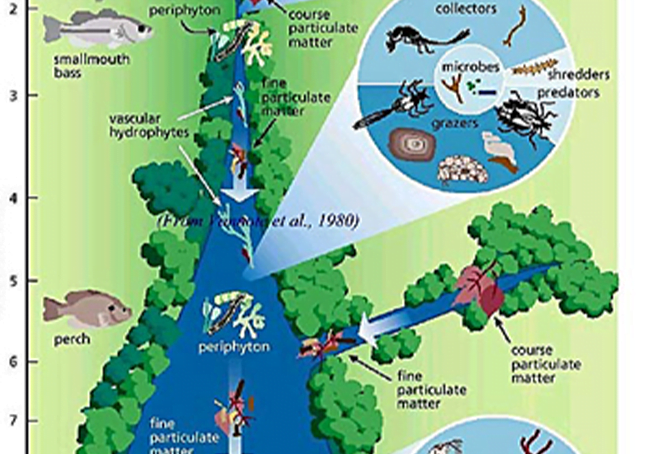River Continuum Concept

The River Continuum Concept (RCC) is a model for classifying and describing flowing water, in addition to the classification of individual sections of waters after the occurrence of indicator organisms.
The theory is based on the concept of dynamic equilibrium in which streamforms balance between physical parameters, such as width, depth, velocity, and sediment load, also taking into account biological factors.
It offers an introduction to map out biological communities and also an explanation for their sequence in individual sections of water. This allows the structure of the river to be more predictable as to the biological properties of the water. The concept was first developed in 1980 by Robin L. Vannote, with fellow researchers at the Stroud Water Research Center.
The River Continuum Concept is based on the idea that a watercourse is an open ecosystem that is in constant interaction with the bank, and moving from source to mouth, constantly changing.[4] Basis for this change in the overall system is due to the gradual change of physical environmental conditions such as the width, depth, water, flow characteristics, temperature, and the complexity of the water.
According to Vannote’s hypothesis, which is based on the physical geomorphological theory, structural and functional characteristics of stream communities are selected to conform to the most probable position or mean state of the physical system. As a river changes from headwaters to the lower reaches, there will be a change in the relationship between the production and consumption (respiration) of the material (P/R ratio).
The four scientists who collaborated with Dr. Vannote were Drs. G.Wayne Minshall (Idaho State University), Kenneth W. Cummins (Michigan State University), James R. Sedell (Oregon State University), and Colbert E. Cushing (Battelle-Pacific Northwest Laboratory). The group studied stream and river ecosystems in their respective geographical areas to support or disprove tenets of their original theory. The research resulted in the publication of 33 scientific papers (see attachment to Bibliography).
The original 1980 paper received the John Martin Award from the Association for the Sciences of Limnology and Oceanography (formerly the American Society of Limnology and Oceanography) that recognizes papers still relevant ten years after their publication. Subsequent research related to the RCC by these scientists has resulted in several more scientific papers that amplify parts of the original RCC.
